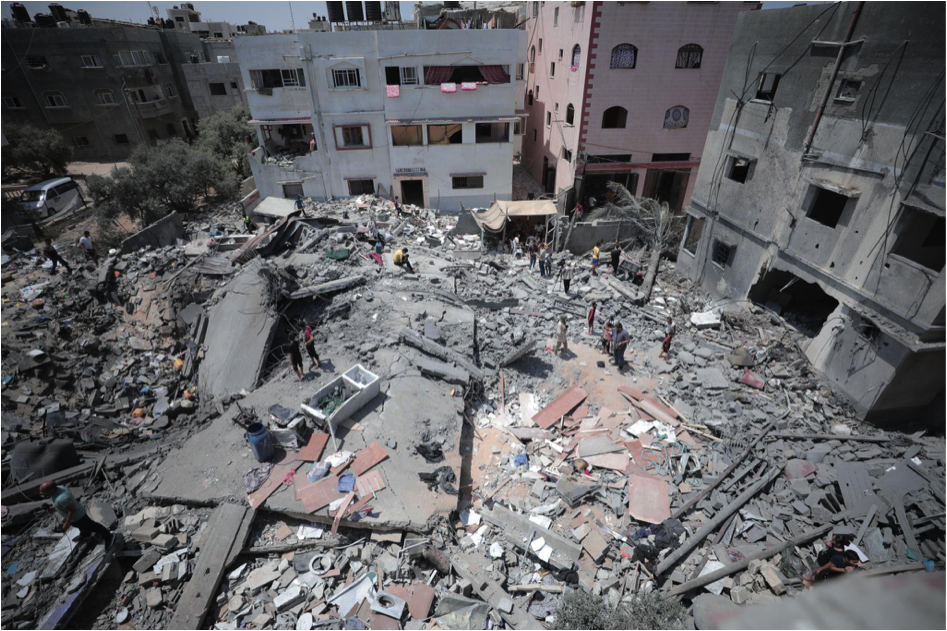No place for refuge and no place for (eventual) return of Palestinians in Gaza
Image by CHUTTERSNAP on Unsplash
by: Zeynep Sahin-Mencutek, Bonn International Centre for Conflict Studies | Soner Barthoma, Uppsala University
After Hamas launched an unprecedented bloody terrorist attack inside Israel on October 7, 2023, which caused a high death toll and involved hostage-taking, Israeli forces responded harshly through indiscriminate, “incessant bombardment of Gaza” and then launched a ground invasion. The UN High Commissioner of Human Rights noted that “there is no safe place in Gaza and there is no way out… The humanitarian and human rights consequences will be devastating and long-lasting. Thousands have already died, many of them children.”
As observers of this deadly and destructive war, we raise the following questions: 1) Is there potential for a refugee crisis to emerge from this conflict? 2) What are the responsibilities of surrounding states, mainly Egypt and Jordan, in accepting refugees from Gaza if they decide to provide safe routes for people of Gaza ? Similar to almost all armed conflicts, forced internal and external displacement are the immediate results of the war for all sides. However, it is much more complicated in this case as there is no place to flee to from Gaza (as long as the borders are closed) and, if they flee, there will be no place for Palestinians to return to, neither temporally nor permanently.
The unfolding events signal a risk of forced displacement and may lead to yet another refugee crisis. Tens of thousands of Israelis were displaced in the aftermath of Hamas attack, and cared for by the Israeli state and society. The number of internally displaced Palestinians reached millions; it is estimated that “some 1.4 million of the 2.3 million residents of the Gaza Strip have fled their homes in an attempt to escape the violence.”
This was in response to Israel ordering about 1 million Palestinians to evacuate the northern Gaza Strip ahead of escalating bombardment and incremental ground incursions. Additionally, the Israeli intelligence acknowledged that it had “drafted a wartime proposal to transfer the Gaza Strip’s 2.3 million people to Egypt’s Sinai Peninsula” and that it had sought the support of Egypt, Turkey, Qatar, Saudi Arabia, the United Arab Emirates, and even Canada to either offer financial support for this plan or take in refugees. Along similar lines,“ Israeli prime minister Benjamin Netanyahu sought to convince European leaders to put pressure on Egypt to accept refugees from Gaza, while the US administration made contingency plans to fund the “potential needs of Gazans fleeing to neighbouring countries”. In addition, the EU and the US have offered Egypt aid and debt relief to open the border. It is not clear whether the proposal of Israeli intelligence is being considered by Israel’s defence establishment or not, but the idea of Palestinians’ expulsion to Egypt and Jordan is not new; Israeli politicians have been calling for similar proposals before the events of Oct 7 and afterward. However, it seems like this idea has become more acceptable to certain governments in the “West”, who are using Hamas' terrorist attack targeting Israeli citizens to legitimise such plans.
Photo by Mohammed Ibrahim on Unsplash
Displacement, asylum and resettlement of Palestinians are much more complex than any other population due to the protracted and precarious nature of the Palestinian refugee situations in the Arab neighbouring countries and their factual lack of a “right of return” since 1948. The initial wave of displacement (or what Palestinians refer to as Nakba) involved the destruction of a large part of the historic Palestinian society. Many residents of Gaza are descendants of those already displaced from today's Israel in 1948 and afterwards. The United Nations Relief and Works Agency for Palestine Refugees (UNRWA) provides direct relief programmes for 5.9 million Palestine refugees, living across UNRWA’s five areas of operation in the Middle East: Lebanon, Jordan, Syria, Gaza and the West Bank. Possible current displacement would mean that Palestinians in Gaza would be displaced (for many yet again) and would have no prospect of returning neither to pre-1948 territory nor to Gaza (eventually). The Universal Declaration of Human Rights (Art. 13) has a direct mention about ‘the right to return to one’s own country’ and this is adopted by international human rights conventions such as the International Covenant on Civil and Political Rights. In practice, however, return after mass expulsion is almost non-existent in many cases of Middle East displacement, such as Armenians, Middle East Christians, Kurds, and Palestinians.
All of these historically displaced and exiled communities hold a ‘nostalgic’ wish to return to the ‘imagined homeland’, otherwise known as the ‘myth of return’. After having been driven out from their homes in different waves either to other safer parts of the country or abroad from the homeland, it was no longer safe for them to return.
The history of Palestine shows that despite a strong wish of many to return, the obstacles are particularly severe. Since 1948 Israel has steadily expelled Palestinians from the remaining land they have left. In addition, it also adopted several punitive systems of control regime of apartheid and persecution such as the blockade over Gaza since 2007, and inflicted suffering of Palestinians that remained through decades. Although the United Nations has long supported a two-State solution to the Israeli-Palestinian conflict, the earlier diplomatic negotiation processes did not result in any positive steps towards this proposal and towards establishing peace. In this light, historic events have demonstrated that it is almost impossible for Palestinians to exercise their right to return, to achieve restitution of confiscated property, and to receive compensation. Not only internally displaced and exiled Palestinians but also neighbouring governments of countries such Jordan and Egypt are well aware that if Palestinians cross into their lands for temporal safety, even if there is a humanitarian corridor or relocation, this would mean the permanent loss of their homes and ultimately settlement in the host country.
For this reason, both governments of Egypt and Jordan - the two countries that share a border with Gaza or the occupied West Bank respectively - have not been eager to accept new displaced Palestinians. They found any proposal pushing them to temporarily or permanently host Palestinians from Gaza or potentially West Bank unacceptable. There is an omnipresent fear among Palestinians as well as the supportive public that such a mass expulsion would have extensive consequences on the Palestinians’ right to establish their own state.
Moreover, Palestinians’ legal situation and access to rights in the neighbouring countries have been precarious for a long time. A significant proportion of the population of Jordan is of Palestinian descent, holds Jordanian citizenship, and thus constitutes a minority community. However, of some 158,000 ‘ex-Gazan’ refugees – Palestinians who fled from Gaza to Jordan in the aftermath of the June 1967 War still experience legal restrictions in terms of social and political rights and contribute to their vulnerable living conditions. In Egypt, policies towards the estimated 50,000–70,000 Palestinians residing on its territory have been influenced by concerns around a threat to stability and often resulted in depriving them of basic rights or leaving them in limbo. For example, thousands of vulnerable young Palestinians are “illegal” despite having been born in Egypt. There is no guarantee that seeking refuge in Egypt or Jordan will not end up with the same vulnerability and precarity, statelessness.
The Egyptian government is also concerned that the mass influx of refugees from Gaza into Sinai would endanger peace and security because of possible attacks and clashes among parties although the Egyptian public shows solidarity with the Palestinians and demand the opening of Rafah crossing for humanitarian access. Similarly, the Jordanian state is against Israel's relocation proposal, fearing it would be followed up by the expulsion of hundreds of thousands of Palestinians living in the West Bank into Jordan. For example, the Jordanian Foreign Minister Khaled al-Safadi warned of a regional conflict should such a scenario take place.
A humanitarian corridor is only a partial and temporary remedy for the protection of all civilians and civilian infrastructure in Gaza, whereas a ceasefire is necessary to end the current humanitarian catastrophe. It is also the only way to prevent any potential (spiralling) regional and global refugee crisis from this conflict. Paradoxically, current excessive use of violence and forced displacement will not have the effect of ensuring Israelis security in the medium- and long-run. Shifting the responsibility onto surrounding states by pushing them to accept potential Palestinian refugees will not lead to a possible end of this historical conflict. For that, a political solution that safeguards the rights of Palestinians is required. Any other solution, such as the focus on neighbouring Arab countries would only constitute “quick fixes” or short-term solutions to the conflict whereby the Palestinian civilians and neighbouring countries would continue to suffer.
As migration researchers, we are deeply concerned about the recent developments in the Middle East, which have already led to a human tragedy. The only lasting solution to this conflict seems to be the implementation of the two-state solution and the right of return of the Palestinians in any peace settlement. To achieve this, there is an urgent need to focus on immediate cessation of the Israeli military campaign and ensure the return of Gaza's displaced population to their homes. Like all other nations, the Palestinians deserve a modern, democratic and, above all, responsible leadership that does not invest in their further "victimisation" and displacement, but rather on ways to achieve long-term peace.
Contact:

